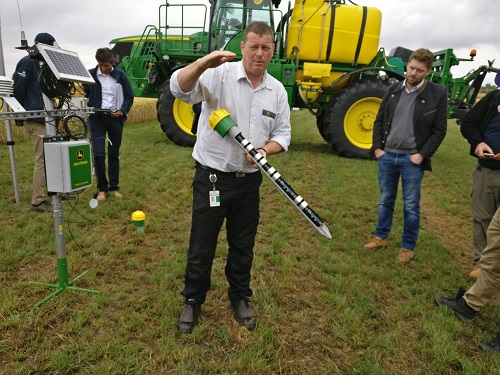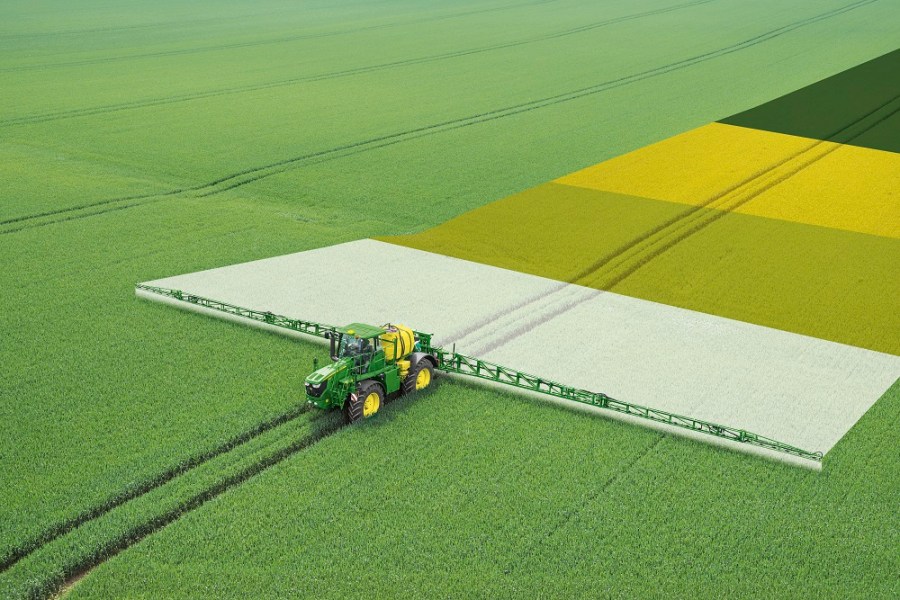New apps and better implementation of precision farming techniques may have far-reaching benefits that go beyond local cost savings or yield enhancements. CPM travels to Brussels to find out.
I believe we can build in some flexibility in how new products are regulated.
By Tom Allen-Stevens
Bayer has unveiled a suite of digital farming solutions it says will help ensure farmers deliver the right spray at the right dose and timing to the right place. Ushering in a new age of digital connectivity, the manufacturer believes such developments in precision technology could even ease the regulatory path for future crop protection products.
Three new apps were previewed at the end of June at an event on Bayer’s ForwardFarm – a 148ha unit near Brussels, where the company’s been trialling and demonstrating precision farming technology since 2009. The Digital Farming apps are set to be rolled out to growers across Europe and further afield over the next 18 months:
- Scouting identifies weeds by image recognition, with pests, diseases and other recognition to follow.
- Timing gathers weather data, which when combined with field-specific information, optimises application timing.
- Field Manager provides field zone-specific maps that allows applications to be optimised to crop potential.
Society has a high expectation of farmers, points out Thilo Kӧnigs, responsible for global commercialisation of Bayer’s digital products. “But we need to balance society’s expectation with science, and farmers must remain profitable. Digital Farming solutions help meet those rising requirements, improve farming efficiency and reduce documentation workload.”
So how has Bayer developed these solutions? The company’s gathered a wealth of data over the years on how its products are best used, explains Thilo Kӧnigs. More recently, it’s brought a number of small companies together that have developed solutions that can digitise the data.

Getting accurate, relevant data to assess field conditions is one of the most important elements of digital farming, notes Eric Teuwsen of John Deere. The company has developed a field weather station with leaf wetness sensors and this soil moisture probe that can provide valuable local information to tailor input dose and timing.
“The aim for Bayer has always been to optimise crop production. To do this you need data from the field, combined with digitised knowledge about the product you’re applying and the conditions in which to do so.”
And now the platforms in agriculture are developing through which to achieve this, he says. There are currently 26M connected farming devices globally. “That’s not actually very many, but by 2020, this is expected to rise to 97M. 70-80% of new farming devices have internet connectivity, and this should rise to 100%.”
When it comes to improving efficiency of crop protection products, he believes there’s considerable scope – research suggests 25% of all weather-related harvest damage can be prevented with prognostic weather modelling and precision agriculture techniques. What’s more, European Crop Protection Association figures indicate that even where inputs are applied, farmers suffer yield losses of up to 40%.
The Scouting apps will be the first to land on European smartphones, although they won’t be available in the UK until sometime after they’re introduced on the continent. Essentially, these are fully digitised versions of the old Schering guides, but with a whole heap more intelligence and functionality.
Spot a weed in your crop, then set the app to scan it. This is then compared with more than 60,000 images in the Bayer database to determine the culprit you have to control. “Currently it’s being trained on 50 of the most common weeds, and is focused on the early growth stages. The success rate varies depends on the available data per weed in the image database.”
So perhaps not quite time to make the agronomist redundant. What’s more it can be a slow process, especially if connectivity is poor, although it’ll work offline, and then go online as and when bandwidth becomes available.
“It’s early days, but the app will improve the more it’s used – it has a self-learning algorithm that’ll get smarter as more and more images are loaded up,” says Thilo Kӧnigs. There’s also geolocational functionality, so you can map your weeds for your own reference, and it’ll build up a picture of global incidence.
This could become especially handy when the disease and insect apps come on stream, that are currently in development. Nutrient and yield estimation, as well as leaf-damage detection are also in the pipeline.
Bayer’s Timing app is based on expert.com – a web-based and field-specific service used by farmers and advisors in parts of Europe to optimise the use of fungicides and insecticides in various crops. It analyses the infection process of fungal diseases, the development and migration of pests (in oilseed rape) and storage risk, based on weather information.
Using data from the nearest weather station to your location, you receive an optimised selection of spray timings, appropriate pesticides and a recommendation with adjusted doses. It’ll work out if you need protective performance from your fungicide or a slug of curative control and calculate the likely duration of action of insecticides.
Field Manager takes this one step further. It’ll take images of your field, either by satellite or drone, and evaluate zones within the field for tweaking the dose applied. “Currently this is determined by Normalized Differenced Vegetation Index (NDVI) – essentially plant green area. But in the future, sensors will be able to pick up disease that doesn’t even show to the human eye. The algorithms we use now can determine how disease risk will grow, and we’re constantly improving these,” notes Thilo Kӧnigs.
The Autopilot function within the app brings you notifications to take action at the right time. “Then you just take a USB stick, plug it into the terminal and let the sprayer go.”
Currently under test with about 400-500 farmers, the first commercial versions will be rolled out across France and Germany for wheat in 2018 and will use satellite images as the input data. There’ll be versions for soya in Brazil and canola in Canada, with the Brazilian app using drone images. Roll out thereafter will depend on success of the initial versions.
Tool is N-Tester-ment to precision prowess
The use of Yara’s N-Tester in France has sky-rocketed following acceptance by authorities of the results as justification for growers to vary N to wheat crops based on crop status, rather than being limited by nitrate restrictions.
The N-Tester is a hand-held leaf nitrogen measurement tool (also available in the UK) that takes readings in a growing crop to establish its exact nitrogen status. It measures the chlorophyll content of the leaf, as this is related to the nitrogen status of the plant. This is used to indicate how much nitrogen the crop requires.
The tool has been evaluated through a series of trials and in France this has been endorsed by the applied research institute for arable crops, Arvalis. In 2012, new legislation governing the use of N, tightly regulated in France, allowed those who could reliably justify an increase to exceed the standard limits.
“Use of the N-Tester took off from 16,000 recommendations to over 87,000 last year,” notes Pedro Parenti, head of marketing at Yara. “It’s now used on 21,000 French farms testing 710,000ha of wheat and generates €19M in extra revenue for those farmers as a result.”
Regulatory hope for precision technology
The work Bayer does with digital farming technology at its ForwardFarm near Brussels is not just about developing tools of practical benefit to growers, according to Marc Sneyders, the company’s sustainable operations manager in Belgium.
“We bring many stakeholders here to show them what’s possible, including food chain representatives, politicians and importantly regulatory authorities. We can do very specialised work looking at how these technologies can reduce the impact of plant protection products on the environment, and demonstrate this. The challenge is how fast the regulations can be adapted to the new technology that’s available,” he explains.
When a new herbicide is evaluated, for example, the worst-case scenario is always assumed for environmental and regulatory purposes, and then statutory limits on its use are set accordingly. “Any pesticide will always be capped at a certain level, but if we can prove that there’s an optimised dose rate for specific conditions, and we can show that we can control those conditions, I believe we can build in some flexibility in how new products are regulated. But we’re not there yet,” he counters.
Bayer started working with fourth generation farmers Jan and Jesse Peeters at Hof Ten Bosch at Huldenberg, near Brussels, in 2009. There’s 57ha of potatoes in a four-year rotation across the hilly fields on well drained and fertile sandy loam soil. Wheat, sugar beet, corn, oilseed rape and barley make up the other crops, totalling around 140ha in the arable rotation. Projects are undertaken in collaboration with public and private partners, such as University of Ghent, John Deere or Yara.
“We started with disease prediction, using farm-based weather station data, connected with other local stations, to get a more accurate picture of disease risk. For potato blight, for example, it can help to know where you are in the disease cycle and whether a protectant or curative product is best used, and at what rate. More accurate data can help you reliably predict which product is best applied within a 12hr window,” explains Marc Sneyders.
The potential benefits for technologies such as auto shut-off and autosteer have also been assessed. “In a potato crop, plants next to tramlines have access to more light, water and fertiliser, so you can increase plant density, we’ve found. This, along with more precise pesticide application and steering technology have delivered benefits worth €3000-4000/yr on this farm,” he notes.
He believes there are four important steps to ensuring digital farming solutions are bringing tangible benefits to a farming system:
- Measure – this is the most important part, he says. The drive for efficiency and expansion has resulted in a generation of farmers less in touch with their land and crops than their fathers or grandfathers. Current technology, such as soil and crop scans, and weather stations, allows growers to reacquaint themselves with crop performance on an intra-field scale.
- Advise – this is the most difficult part, and turns the gathered data into recommendations and actions. It relies on good knowledge and robust algorithms, and the industry together with the farmers are “getting there”, he says.
- Implement – this is where farmers started with precision technology, in many cases, and is the easy part, provided the equipment works and technologies are compatible.
- Evaluate – Yield-mapping, benchmarking and sharing results are essential ways to assess how it’s working at a farm level, and progress the technology.
And the potential rewards are high, he stresses. “Precision application encourages trust in the food chain, and regulators should take greater account of this technology. Farmers don’t always need robust dose rates of a pesticide applied over a whole field. If we’re to face more stringent caps in the future, we need technologies that can focus effective control where it’s needed to limit overall use of inputs. If we can show such flexibility works and is reliable, this can ensure a more sustainable future for farming,” concludes Marc Sneyders.




